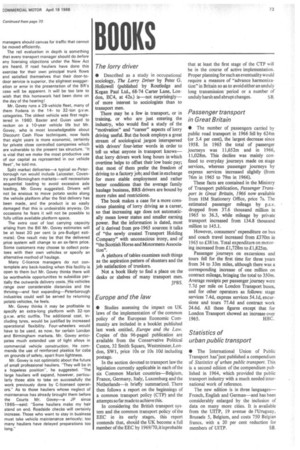BOOKS
Page 75

If you've noticed an error in this article please click here to report it so we can fix it.
The lorry driver
• Described as a study in occupational sociology, The Lorry Driver by Peter G. Hollowell (published by Routledge and Kegan Paul Ltd., 68-74 Carter Lane, London, EC4, at 42s.) is—not surprisingly— of more interest to sociologists than to transport men.
There may be a few in transport, or in training, or who are just entering the industry, who would find a study of the "motivation" and "career" aspects of lorry driving useful. But the book employs a great stream of sociological jargon interspersed with drivers' four-letter words in order to tell us what anyone in transport knows— that lorry drivers work long hours in which overtime helps to offset their low basic pay; that most of them prefer the freedom of driving to a factory job; and that in exchange for more stable employment and rather better conditions than the average family haulage business, BRS drivers are bound by more rules and restrictions.
The book makes a case for a more conscious planning of lorry driving as a career, so that increasing age does not automatically mean lower status and smaller earning power. But the information is dated, most of it derived from pre-1965 sources: it talks of "the newly created Transport Holding Company" with unconscious irony, and of "the Scottish Horse and Motormens Association".
A plethora of tables examines such things as the aspiration pattern of shunters and the job satisfaction of trunkers.
Not a book likely to find a place on the desks or shelves of many transport men. JPBS.
Europe and the law
• Studies assessing the impact on UK laws of the implementation of the common policy of the European Economic Community are included in a booklet published last week entitled, Europe and the Law. Copies of this 96-paged publication are available from the Conservative Political Centre, 32 Smith Square, Westminster, London, SW!, price 1 Os or lOs 10d including postage.
In the section devoted to transport law the legislation currently applicable in each of the six Common Market countries—Belgium, France, Germany, Italy, Luxemburg and the Netherlands—is briefly summarized. There then follows a report on the beginnings of a common transport policy (CTP) and the attempts so far made to achieve this.
In considering the British transport system and the common transport policy of the EEC in its early stages, this report contends that, should the UK become a full member of the EEC by 1969/70, it isprobable that at least the first stage of the CTP will be in the course of active implementation. Proper planning for such an eventuality would require a measure of "advance harmonization" in Britain so as to avoid either an unduly long transmission • period or a number of unduly harsh and abrupt changes. S B.
Passenger transport in Great Britain
• The number of passengers carried by public road transport in 1966 fell by 624m (or 5.4 per cent), the largest decrease since 1958. In 1965 the total of passenger journeys was 11,652m and in 1966, 11,028m. This decline was mainly confined to everyday journeys made on stage services, whereas passenger journeys by express services increased slightly (from 76m in 1965 to 79m in 1966).
These facts are contained in the Ministry of Transport publication, Passenger Transport in Great Britain, 1966 now available from HM Stationery Office, price 7s. The estimated passenger mileage by p.s.v. dropped from 37.6 thousand million in 1965 to 36.3, while tnileage by private transport increased from 134.8 thousand million to 145.1.
However, consumers' expenditure on bus and coach travel increased from £370m in 1965 to £381m. Total expenditure on motoring increased from £1,728m to £1,825m.
Passenger journeys on excursions and tours fell for the first time for three years from 34 to 33m miles, although there was a corresponding increase of one million on contract mileage, bringing the total to 350m. Average receipts per passenger journey were 7.7d per mile on London Transport buses, and for other operators as follows: stage services 7.4d, express services 54.1d, excursions and tours 77.4d and contract work 24.6d. All these figures except that for London Transport showed an increase over
1965. H13C.
Statistics of urban public transport
• The International Union of Public Transport has'just published a compendium of Statistics of urban public transport. This is a second edition of the compendium published in 1964, which provided the public transport industry with a much needed international work of reference.
The new edition is in three languages— French, English and German—and has been considerably enlarged by the inclusion of data on many more cities. It is available from the UTTP, 19 avenue de l'Uruguay, Brussels 5, Belgium, and costs 750 Belgian francs, with a 20 per cent reduction for
members of UITP. SB.








































































































































